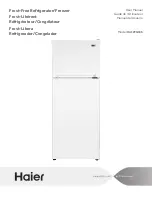
O-UC12-FEB23-3
Page 1
Health and Safety
Only
a
qualified
refrigeration
engineer/technician, who is familiar with
refrigeration
systems
and
components
including all controls, should perform the
installation and start-up of the system. To avoid potential
injury, use care when working around coil surfaces or
sharp edges of metal cabinets. All piping and electrical
wiring should be installed in accordance with all
applicable codes, ordinances, and local by-laws.
Before Installation
•
Ensure the units received are the correct models for the
intended application.
•
If the holding charge (4 bars ± 1bar nitrogen) is not
present, do not use the product and contact the sales
representative immediately. (Manufacturer’s warranty is
void for damage caused by incorrect application or unit
mishandling).
•
The holding charge should be safely released through
the schrader port on the suction header.
•
Check there is no damage to the units (piping not dented,
fan motor’s electrical box with no sign of cracks). Any
damage should be reported to the supplier immediately.
•
Check to ensure tightness for the wiring and the fan.
•
Check that the proposed equipment locations are suitable
and provide adequate support for the weight of the units.
Offloading and Lifting
•
Whenever handling a unit with packaging, it should be
from the base (refer the marking on the carton box) and,
where possible, all packing and protection is kept in
position.
•
When offloading the unpacked unit on the ground, the
drain pan shall face upwards to avoid denting the drain
pan (slope).
•
Lift the unit from two ends for installation. If a lifting
instrument is used, ensure cushion is used to protect the
unit casing from damage.
•
Do not drop the unit. Should this inadvertently happen, it
should be immediately inspected for damage.
During Installation and subsequent maintenance
•
Installation and maintenance are to be performed only
by qualified personnel who are familiar with local codes
and regulations and experienced with this type of
equipment.
•
Safe working methods are identified, and operatives
have suitable PPE.
•
Ensure the working area has adequate ventilation during
brazing procedures.
•
The units contain moving machinery and electrical power
hazards, which may cause severe injury or death.
Disconnect and shut off power before installation or
service of the equipment.
•
Refrigerant release into the atmosphere is illegal. Proper
evacuation, recovery, handling, and leak testing
procedures must always be observed.
•
Units must be
grounded to the screw terminal
labelled
•
No maintenance work should be attempted prior to
disconnecting the electrical supply.
•
The electrical covers and fan guards must remain always
fitted.
•
Use of the units outside of the design conditions and the
application for which the units were intended may be
unsafe and be detrimental to the units, regardless of
short- or long-term operation.
•
The units are not designed to withstand loads or stress
from other equipment or personnel. Such extraneous
loads or stress may cause failure/leak/injury.
Installation
Unit location and Fixing
•
All indoor units must be level in all directions, to ensure
water condensation can be properly drained out.
•
The indoor units can be mounted directly to the ceiling
utilizing the fixing holes on the top of the unit. No
additional brackets are required.
•
Position the indoor unit where the optimum airflow can be
achieved. Avoid locating in corners or in alcoves which
may restrict airflows. For best performance, it is
desirable to arrange the air blowing toward the door to
minimize the entrance of warm moist air when door is
open. Light fixtures, shelving and product boxes must be
arranged in such that it does not block the air intake and
air discharge from the unit cooler.
•
A minimum 10mm raw bolt type fixing is required with a
large steel washer to bear the indoor unit weight. It is
important to ensure that the wall/ceiling can withstand
the unit weight and that all fixings are secure.
•
The installation location should allow sufficient space for
air flow and maintenance around the units:
•
The fan face must be located a minimum of 600mm (H)
from walls to assure unrestricted air intake.
•
Ensure that the ceiling can withstand the unit weight
and that all fixings are secure.






























